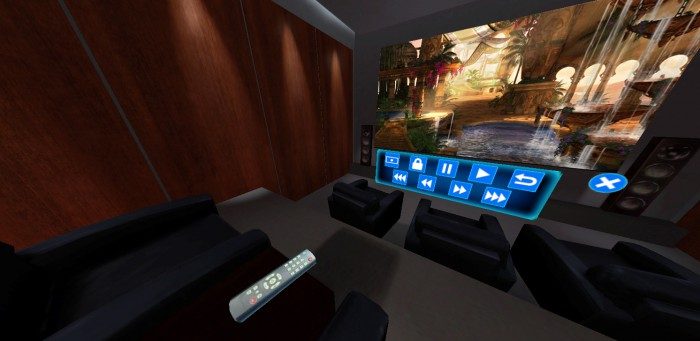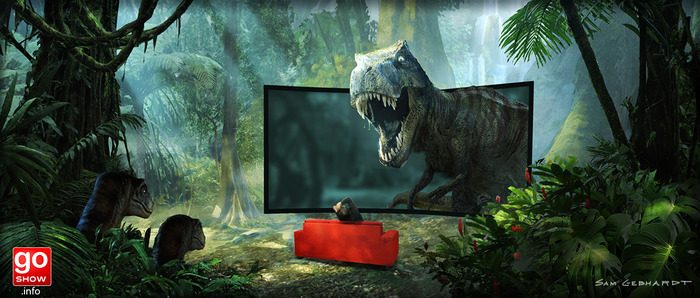 Sam Gebhardt, developer of VR cinema app Go Show, has launched a Kickstarter campaign to bolster the feature set of the app. Designed for Smartphone VR headsets, Gebhardt hopes to add custom theaters, streaming media support, and more to Go Show.
Sam Gebhardt, developer of VR cinema app Go Show, has launched a Kickstarter campaign to bolster the feature set of the app. Designed for Smartphone VR headsets, Gebhardt hopes to add custom theaters, streaming media support, and more to Go Show.
Already available for $3.99 on Google Play, Go Show allows anybody with a smartphone and VR attachment to watch movies or video content in a virtual cinema environment. The Go Show Kickstarter has just launched; Gebhardt plans to use the pledges to fund custom built theater environments, support for iOS devices, streaming media from YouTube, Hulu, and others, proper distortion correction, and more. Stretch goals include support for 360 degree videos, Oculus Rift, and the Avegant Glyph.
Having already downloaded the basic version of Go Show to my Nexus 5, I can say it is surprisingly effective. Although you are effectively seeing less of the movie due to it being surrounded by additional content, the sense of private immersion is undeniable and it feels very natural.
Like other mobile based VR apps, it utilises the gyroscopes and accelerometers of a smartphone to recreate head tracking so the user can look around the environment surrounding a theater screen. Controls are activated by looking at typical icons (pause, fast forward etc) and Gebhardt aims to add further features to the interface. Other goals include streaming media support, adjustable screen position and convergence, lens correction and ‘pixel filtering’.

For Gebhardt , Go Show is the result of many years experience and passion for film and computer animation. For more than a decade he worked as an artist on films such as Shrek 2, Open Season and the Aviator, at studios like Blur, Sony and DreamWorks. As video games became more popular, Gebhardt switched to game design and worked for major studios such as Activision Blizzard, Ncsoft and THQ-Vigil Games.
It was a eureka moment for him when the Oculus Rift was announced and VR, movies, and animation has culminated in an app that could be of major interest, not just for consumers, but also for movie marketing departments who could offer clips and themed cinema environments (imagine watching the trailer of Gravity 3D on a floating space station cinema).
Gebhardt has even experimented with creating his own hardware… out of Lego which he says worked “surprisingly well”. In a similar style to FOV2GO, he has also designed a blueprint for those who fancy creating their own VR add-on for a Samsung Galaxy Note 3, S3 and S4.
See Also: DIY Guide – Build a Smartphone VR Headset That Plays Oculus Rift Games and More for $20
We have seen a similar application for the Oculus Rift. VR Cinema 3D by Joo-Hyung Ahn puts the user in a simulation of a traditional cinema. Like Go Show, VR Cinema 3D uses local content, but judging from the forums there is demand for streaming content from platforms such as YouTube and Hulu so this is likely to be the next stage of functionality.
Interview with Sam Gebhardt, Developer of Go Show
The Kickstarter campaign has just gone live and I caught up with Gebhardt to firstly ask why he thinks this would be more appealing than viewing full screen content:
Gebhardt: I think we are creating a new unique experience. For instance… I was flying home after a very long and crowded CES. I was sitting in a packed plane at night with every seat filled. Once we got in the air I loaded up a movie and BOOM, I wasn’t crammed between passengers. I enjoyed the movie and was actually refreshed by the time we hit the ground. I had thought about that situation before but actually putting it to the test and getting a good result was a lot of fun. I think as headset technology improves the result will be even greater. To answer your question more directly… just try it… it’s not like watching a movie on your phone, I can promise that. 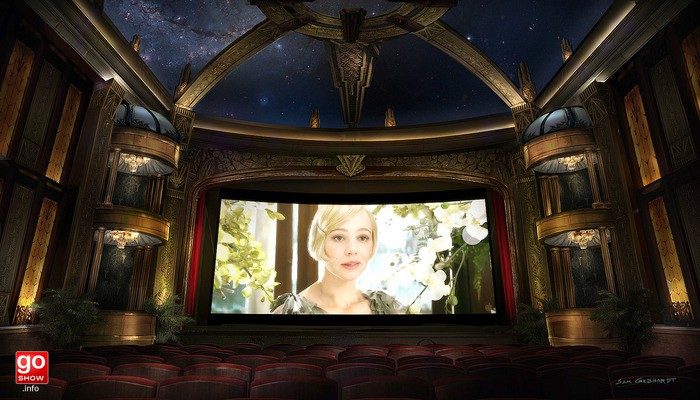
Road to VR: How will the distortion correction work when so many smartphone VR add-on devices are expected to be launched each with different lens configurations?
Gebhardt: We have already tinkered around with different settings for the distortion. Being that there are many devices and lens configurations everything would be accessible so that the user could “tune” the app to best fit his or her hardware setup. The plan is to have some general settings out of the box but you could also dig deeper into advanced settings.
Road to VR: In your Kickstarter page you talk about pixel filtering. What is that?
Gebhardt: It essentially is when the device compares each pixel to the one next to it and adjusts them to create a more cohesive image. It really helps when you have a bright character on a dark background. We have already done some testing with one of the older hand sets with only a 1280 x 720 screen and the result was amazing, We can’t wait to get back into it and try it on one of the new devices with the HD or 1920 x 1080 display (most of the newer phones have this as a standard resolution). Filtering technology has been around for a while but just recently optimized for game engines. As the demand grows I think we should see significant advances in this area as well. 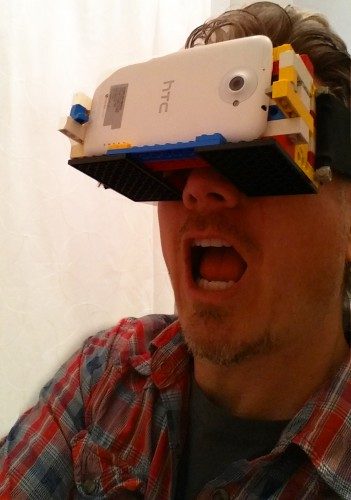
Road to VR: How would Go Show support 360 content? Won’t that move away from the virtual cinema concept?
Gebhardt: In the alpha build we have running now you are loaded into a new cinema. It consists of a spherical screen that your camera (head) is in the exact centre of. Here you can freely look in any direction while the movie is playing. We also have a 360 3D movie version that has two spheres in the exact same space. Through camera layers we are able to pipe the correct screen to the left and right eyes. The technology for shooting 360 3D is still very new but the movies we tested created an experience like nothing else. Also the ability to render CG into a 360 3D space is something I’m personally very excited about. You could essentially have mind blowing pre-rendered films on a somewhat low end smart-phone. Imagine flying on an Ikran though the Hallelujah Mountains on Pandora….
Road to VR: Do you plan to license / white label the app?
Gebhardt: We are entertaining several business models. Without saying too much our goal is to bring the most polished and easy experience to the user as possible, really allowing the customer to decide what’s right for them. Ultimately it’s about providing the highest quality and taking care of the early adopters.
Road to VR: Do you hope content producers will develop bespoke content for the Go Show app and how will you support them with the tools so the on-screen content can be synchronised with changes in the CG environment (for example, the environment shakes during an earthquake scene in a movie).
Gebhardt: Absolutely, we think there is a huge potential to build a creative space where custom content would be a driving force in the VR / immersive media market. Our goal is to create a foundation platform that would allow developers to easily contribute and benefit from what we hope to be an ever expanding user base.
Road to VR: How will new powerful smartphone chips (such as the Snapdragon 805) enhance the Go Show experience?
Gebhardt: Great question! I don’t think we know yet but just off the top of my head and reading through forum posts, the sky is the limit. I think being able to augment the movie you are watching at key moments would be exciting. For instance some of the 3D content could actually come out from the screen and go past your head. Also being able to alter environments depending on what’s happening could be terrifying in a horror movie.
Road to VR: What about multi-view watching? (having a drink with someone in a bar with a big screen?)
Gebhardt: Great idea! I think that’s just the beginning, because we are mobile and location aware, the possibilities are big. A conversation I had recently involved being able to experience the game or race from the athletes point of view, whether it was catching a Hail Mary in the last seconds of the game or roaring through the finish line at 130+ mph.
If you would like to support Go Show head over to the Kickstarter page. $9 will get you the full Go Show app with two theater upgrades and for those feeling flush, a $3000 pledge will entitle you to your own bespoke theater environment. 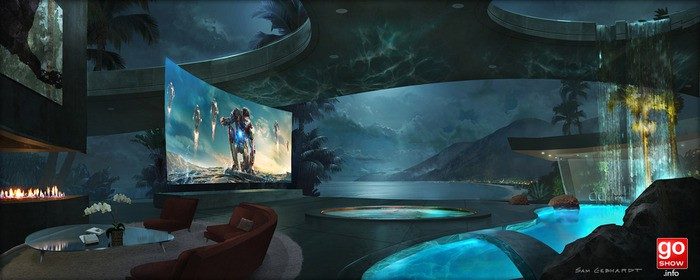
I am particularly excited about Go Show as it is a perfect case study for mobile based VR. Latency is not an issue as the user does not need to move his or her head very fast; it utilizes content people already like (by virtue that it is already on the user’s phone) and has great potential for shared experiences over the mobile networks, something I am sure Facebook would be keen to investigate. Expect invites to watch a movie trailer in a fantasy environment from your friends soon!

